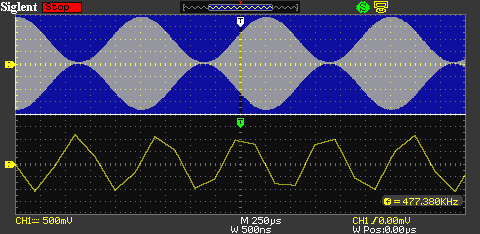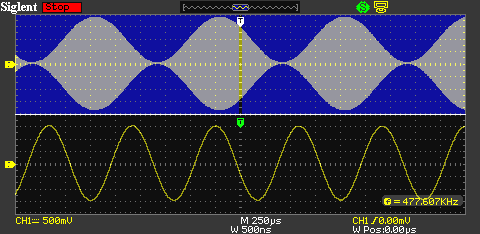Benefits of Deep Memory
October 23, 2017
Digital storage oscilloscopes (DSOs) operate by sampling the voltage values at each active input channel at specific time intervals. The inverse of this time interval is the called the sample rate. The sample rate is usually shown in Samples/second, or Sa/s. For most scopes, the sample rate is dependent on the configuration of the scope, with the main contributors being the horizontal timebase (divisions/sec) and the memory depth selected for the storage of the collected waveforms.
If the sample rate is too low, there may not be enough data to accurately reproduce the waveform. In Figure 1 below, we have captured an AM waveform using normal memory depth on a SIGLENT SDS1102CML scope (40kPts @ 2.5MSa/s sample rate). Note that the waveform is not very smooth.
This is due to the slow sample rate that was used to collect the data:

Figure 1: AM modulated input captured with 40kpt memory depth.
This can be solved by adjusting the horizontal timebase and/or enlarging the memory depth. Scopes with “deep memory” can store millions of points per waveform at a high sample rate. This increases the horizontal resolution of the acquisition and stores a longer time segment of the waveform.
In Figure 2 below, we have the same AM input signal and timebase, but we have enabled the long, or deep, memory of the scope. This changes the sample rate to 50MSa/s, and provides much more waveform detail.

Figure 2: AM modulated input captured with 2Mpt memory depth.
Deep memory provides higher sample rates over longer acquisiton times. This can add essential details to data, especially when you are zooming in on specific features.
